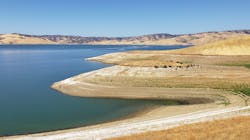Calif.'s Central Valley groundwater may not recover from droughts
Groundwater in Calif.'s Central Valley is at risk of being depleted by pumping too much water during and after droughts, according to a new study in the American Geophysical Union journal Water Resources Research.
The study finds that groundwater storage recovery has been dismal after the state’s last two droughts, with less than a third of groundwater recovered from the drought that spanned 2012 to 2016.
Under a best-case scenario where drought years are followed by consecutive wet years with above-average precipitation, the researchers found there is a high probability it would take six to eight years to fully recover overdrafted water.
However this best-case scenario, where Calif. has six to eight consecutive wet years, is not likely because of the state’s increasingly hot and dry climate. Under a more likely, drier climate, there is less than a 20 percent chance of full overdraft recovery over a 20-year period following a drought.
The Central Valley produces about a quarter of the nation’s food and is home to around 6.5 million people. Using too much groundwater during and after droughts could soon push this natural resource beyond the point of recovery. The study finds recovery times can be halved with modest caps on groundwater pumping in drought and post-drought years.
“This is really threatening,” said Sarfaraz Alam, a hydrologist at Stanford and lead study author. “There are many wells that people draw water from for drinking water. Since [groundwater is] always going down, at some point these wells will go dry and the people won't have water.”
Measuring depletion
The researchers combined NASA satellite data, well level data, detailed groundwater models and calculations of water inflows versus outflows to create a reliable assessment of groundwater storage data. They then used those data to predict how long it would take groundwater to fully recharge after droughts in the region under different climate scenarios.
Calif. has faced three major droughts since 2000: from 2007 to 2009, 2012 to 2016 and the state’s current drought period, which began in 2020. Researchers found that of the 19 cubic kilometers of groundwater (about 10 percent of the water volume in Lake Tahoe) lost during the 2006-2009 drought, only 34 percent was recovered after the drought. For the 2012-2016 drought, only 19 percent of 28 cubic kilometers lost were recovered.
The researchers attributed especially low recovery in the post-2016 drought period to significant overdraft compared to limited water availability.
"It's very hard to [measure] the volume of groundwater being pumped by humankind, and we really want to know that because we really want to know how much we’re depleting the groundwater,” said Donald Argus, a geophysicist who researches water resources at the NASA Jet Propulsion Laboratory who was not associated with the study. “If we start to understand how much water is replenished each year or each rainy season, then we get an idea of how much groundwater we’re pumping out, and whether we can sustain it or not.”
Opportunities for management
Despite the grave predictions of recovery time, researchers found that there is hope for increased water recovery when management practices are put into place. If Calif.'s climate remains at historical levels, rather than worsening with climate change, groundwater extraction caps could significantly improve aquifer resistance to drought. Overdraft recovery times could be reduced by about two times if pumping restrictions are put in place during no-drought years and could be reduced by up to four times with pumping restrictions, according to the study.
However, these management practices can create complicated trade-offs for laborers in the region, according to Alam. The livelihoods of those for those who depend on the region’s agricultural industry is threatened when pumping for agricultural purposes is capped to prioritize drinking water. But finding a balance of water supply and demand will be necessary to continue to use the Central Valley’s aquifer resource.
